








April 10th, 2006 - Post No. 50

On Monday, April 10th, I catch a ride from a service taxi in front of the Catholicosate, and head out to visit a family of former Quebeckers, now living in Chekka, Lebanon, a few minutes south of Tripoli. Georges Khoury and Brigitte Seux have three children César (15), Élissa (14) and Octave (12).
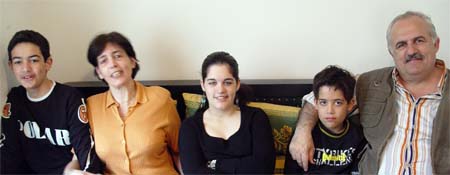
The family moved back to Georges' native Chekka four years ago, after 20 years in the province of Quebec -- 14 of which, in Old Quebec City. Georges left Lebanon during the civil war to continue his studies in France where he met Brigitte and with her immigrated to Quebec in the early 1980s. For many years, Georges was the owner operator of the Byblos, a popular Lebanese restaurant on rue Ste-Ursule in the old city. Cathedral parishioner Donna Mendel suggested I contact the family while here, and it's taken several phone calls emails, and some rescheduling, but we finally find a good day for me to travel to visit them in the north of Lebanon.
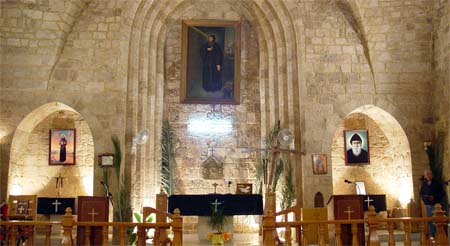
As arranged, Georges meets me at the Falcon gas station on the coastal highway (the drop off point for the service taxi) and takes me on a quick tour of the town of Chekka. First stop on the tour, the Maronite church of St. Carlotta, a couple of centuries old, built entirely from the local sandstone.
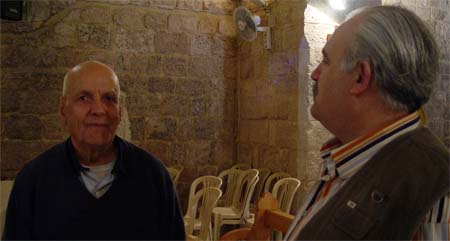
The sacristan for the church, a friend of Georges -- George seems to know just about everyone in Chekka -- comes across from his home and opens the door for us. He's been looking after the church for about 60 years and is happy to show us around.
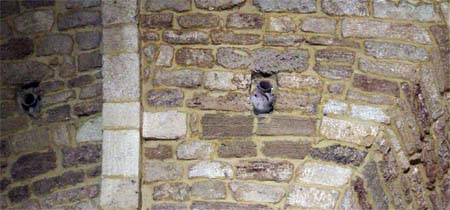
Georges points out an interesting feature in the design of the stone vault (ceiling). Empty clay jars have been placed in the stone work (two are pictured here), which Georges suspects were intended to improve the building's acoustics.
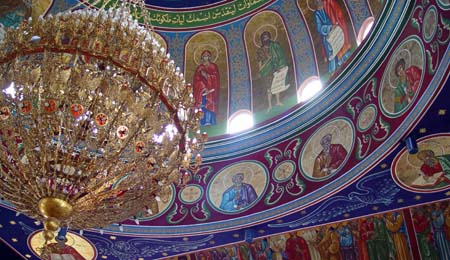
Next stop on the tour is the new Greek Orthodox church near the seashore in the village. Another friend of Georges opens the door of this building for us as well. The church was completed only a few years ago, and every inch of interior wall space has been covered with beautiful frescoes.

Our host invites us to consider one of the frescoes in particular, a portrayal of the Last Judgment. not unlike a similar painting in the Cathedral of the 40 Martyrs in Aleppo.
Of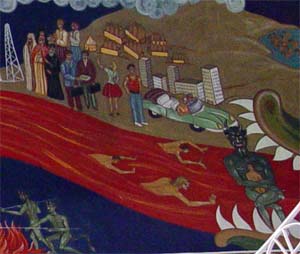 particular interest in this 21st century version of the familiar theme,
are the folks sorted out to be chomped up in the jaws of hell (right
side of the fresco), the ranks of the corrupt include an oil baron, a
cleric, a lawyer, a businessmen, a couple of wayward teenagers ...
polluters, war makers and unbridled consumers. On the other side
of the fresco,
the folks selected for heaven (see above, left) ... portrayed in scenes
showing the merciful in action, "I was hungry and you fed me,
naked and you clothed me, sick and in prison and you visited me ..."
particular interest in this 21st century version of the familiar theme,
are the folks sorted out to be chomped up in the jaws of hell (right
side of the fresco), the ranks of the corrupt include an oil baron, a
cleric, a lawyer, a businessmen, a couple of wayward teenagers ...
polluters, war makers and unbridled consumers. On the other side
of the fresco,
the folks selected for heaven (see above, left) ... portrayed in scenes
showing the merciful in action, "I was hungry and you fed me,
naked and you clothed me, sick and in prison and you visited me ..."
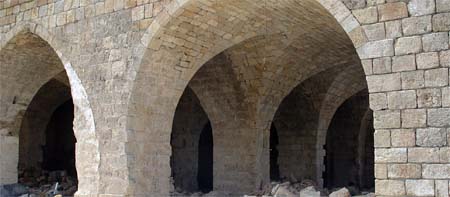
Next stop on our quick tour of Chekka is a construction site where we meet yet another one of Georges' friends (I think he really does know everyone in town!) who is busy restoring an old seaside factory, removing the plaster covering and repairing the stone vaulting. One of the workmen is scoring the face of the sandstone blocks in the traditional style.

Along the shore we see a recent restoration project, with the waves of the Mediterranean lapping against its foundations.

Finally, the mini-tour complete, we drive into the centre of the village of Chekka to Georges' ancestral home to meet Brigitte, the kids and Georges' mother (pictured here).
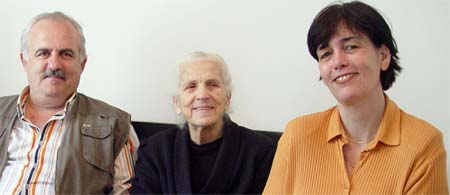
The home is situated on a large piece of property, perhaps a half acre or more, with a variety of trees ... cedar, orange, olive and other fruits.

George and his brother have a project to build a wall to border the drive way (along the back of this photo) and work is progressing smoothly.
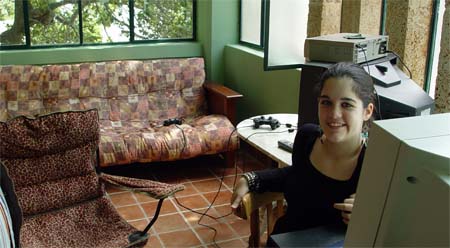
Georges and Brigitte have steadily been making improvements to the house. They have recently completed this room, formerly an open balcony, which they have closed in with glass to make a video and computer room for the family.
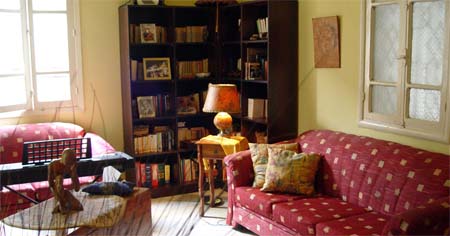
The Khourys live on the second level, and George's mother, a sister and a brother live in the apartment on the ground floor of the house.
It is the beginning of the Easter holiday, and César and Élissa have activities planned for the afternoon. So Georges, Brigitte, Octave and I head out to visit the ancient port city of Tripoli.

Along the way we stop at an ancient Greek Orthodox convent. Next to the convent, workers are busy harvesting sea salt from the Mediterranean. Water from the sea is captured in shallow pools, and salt is harvested after a long process of evaporating the water in the sun.
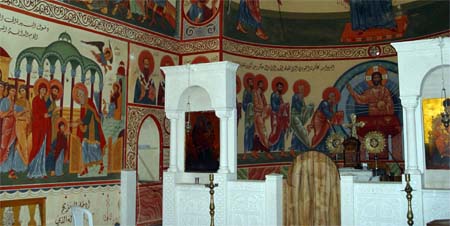
The Mother Superior of the Greek Orthodox convent greets us from a second floor window (and does not agree to have her picture taken from there!) She tells us that the convent was founded in the second century and asks the Lebanese soldier stationed at the convent's door, to let us into the courtyard to visit the chapel. She explains that the walls here have also recently been painted by three monks from France who took four years to paint the interior of the old stone vaulted chapel.
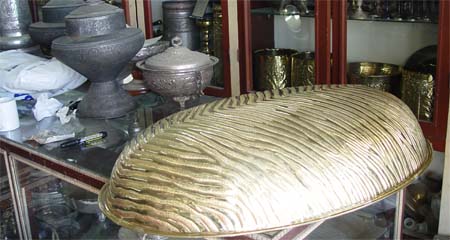
Next stop along the way is a village that specializes in hammered
metal products like those pictured here. It is a Moslem holiday today,
Mohamed's birthday, and we are pleasantly surprised when we
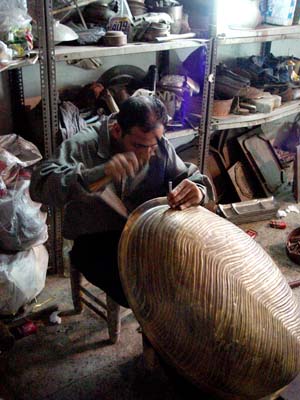 get
out of the car and hear a sharp metallic tapping and discover that the
workshops are open, despite the holiday, and work underway.
get
out of the car and hear a sharp metallic tapping and discover that the
workshops are open, despite the holiday, and work underway.
The large serving platter upside down in the picture above, is for banquets -- used to serve quantities of meat and vegetable dishes. The platter or serving bowl is machine stamped and a pattern is drawn on the metal with a marker pen. Then the worker, using a metal punch or chisel, patiently hammers out the bowl's decoration.

Following the old coastal road, we finally reach the centre of Tripoli, and find a parking spot (on the second drive around) across from the famous Tripoli souq -- the covered market area.
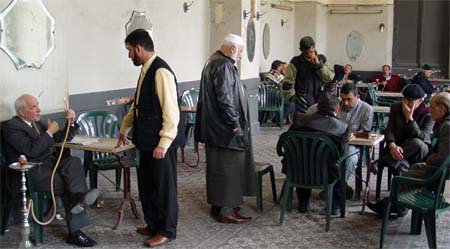
Georges takes us into an old and very traditional coffee shop, where locals while away the day sipping coffee, playing checkers, or drawing on a nargilé (water pipe). Brigitte comes along, and no one seems to mind seeing a women in this decidedly male domain. Georges reflects that this is the charm of the Middle East, folks are pretty relaxed about things like the observance of social rules.
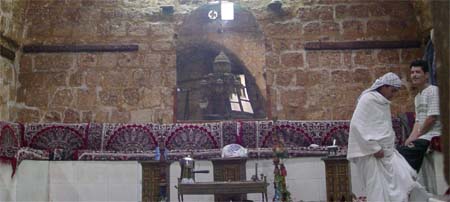
The acid test for this principle of relaxed standards comes when we walk into an ancient Turkish bath. The gentlemen in the towels does make a bee-line to the change room when he catches sight of Brigitte, but no one makes a fuss.
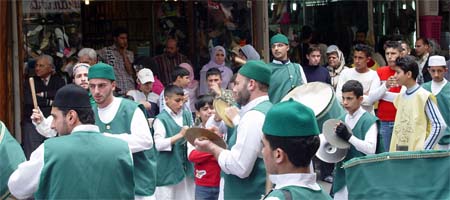
We are drawn to the sound of flutes and drums, and find a group of Islamist seminarians doing something of a Salvation Army routine in the middle of the market, to celebrate the birthday of the prophet. I can't help but think that the students in this group look just like the seminarians in Bickfaya, only a difference in uniform ... and a difference in intensity, of course.
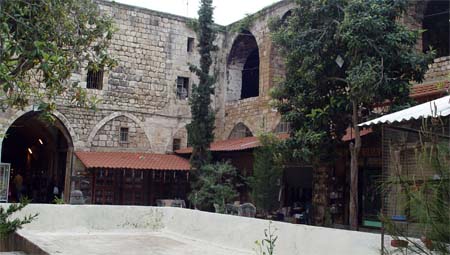
Georges, who knows the souq like the back of his hand (Brigitte knows
her way around pretty well too!) leads us into an open courtyard and a
former inn for caravan travellers. At the centre of the courtyard, a
large trough where camels and horses were watered, and where sleeping spaces
once lined the balcony, with common areas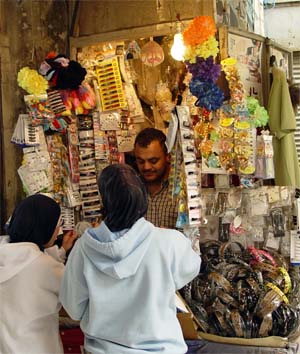 (for food and drink)
on the lower level.
Today the soap vendors have their shops in the old inn and
the air is filled with the
perfumes of a wide range of locally made soaps (from the medicinal to
the cosmetic.)
(for food and drink)
on the lower level.
Today the soap vendors have their shops in the old inn and
the air is filled with the
perfumes of a wide range of locally made soaps (from the medicinal to
the cosmetic.)
Next we stop to have a look at what Georges calls the "world's smallest store." The shop is little more than a closet with doors (upper right) that fold in and lock at night. How would you like to spend your day minding this store?
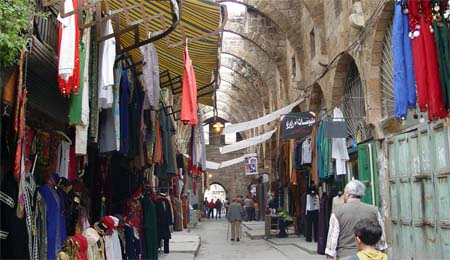
Typically, it seems, the souq is organized by product sectors. This
is a photo of a stretch of covered market specialising in traditional
middle eastern clothing and outfits.
We stop for a break and a glass of freshly squeeze orange and carrot juice, in an open café in a large covered area dating back to the Roman or Byzantine period (up to the arrival of Islam in the region.) The columns and vaults pictured here date back more that 1500 years.
After a couple of hours exploring the souq, we make our way through the Christian quarter (a half dozen churches within a few blocks) to collect the car and drive to one of the more famous of Tripoli's cultural institutions: Abdul Rahman Hallab & Sons Sweets Palace!
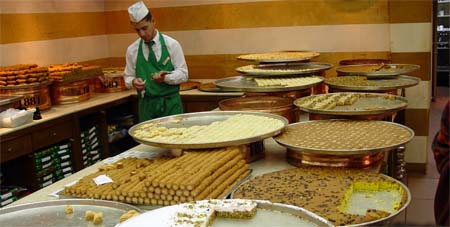
Hallab's Tripoli based business has several outlets in Syria and Lebanon and is the place to go for pastries and other Middle Eastern delights. Georges asks for a tour of the plant, and we are taken behind the scenes where 90% of Hallab's 400 Tripoli employees are hard at work.

Once finished with the tour, we settle in for a wonderful meal -- all that work exploring the souq has made us pretty hungry! We are served mezze, with humus and salads, and then a couple of rice dishes (one with lamb the other chicken) and a platter of stuffed zucchini ... delicious! For dessert, fresh strawberries (very much in season now) with whipped cream. Later Georges presents me with a kilo of pastry fresh from the kitchens we have just visited ... will have to add another kilometre or two to my daily walk to burn the extra calories!
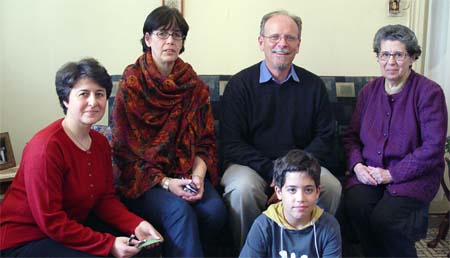
In another part of the Hallab building, still part of the original apartment block, we stop to visit an Armenian family, the Gondjians, one of Brigitte's teaching colleagues, Arpie (Taline is her real name) picture left, and her mother Mélinée (right). It is fun to see their surprised look when this visitor from Canada greets them with "Parev, inch bes-ek?" (Hello, how are you?) From the balcony of the large flat, we can spot the steeple of the local Armenian Orthodox church, barely a block away.
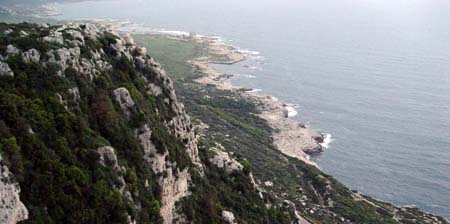
Arpie joins us for the return trip to Chekka and a visit to another Greek Orthodox convent perched on a cliff over looking the sea, to the south of the village. We hope to see the sunset there, but fog coming in off of the Mediterranean blocks the view. It is all very nice just the same. After a day in the crowded and busy city, it's a pleasure to take in the splendour of this dramatic shoreline.
A wonderful day enjoying remarkable hospitality in the north of Lebanon draws to a close; and Georges, a very gracious host, gives me a ride all the way home to the Armenian Catholicosate in Antelias.
Mille mercis à nos amis québecois à Chekka!